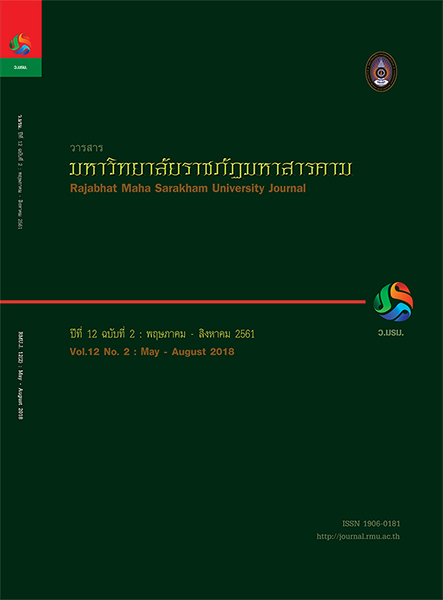กระบวนทัศน์การจัดการภาครัฐแนวใหม่: ทิศทางการปฏิรูประบบราชการ
Main Article Content
บทคัดย่อ
วิวัฒนาการของกรอบการศึกษารัฐประศาสนศาสตร์ได้เคลื่อนตัวและมีพัฒนาการมาหลายกระบวนทัศน์ โดยกระบวนทัศน์การ
จัดการภาครัฐแนวใหม่นำมาสู่การเปลี่ยนแปลงการบริหารจัดการภาครัฐอย่างมากมายการจัดการภาครัฐแนวใหม่มีฐานรากจากทฤษฎี
หลายตัวเป็นต้นว่าทฤษฎีทางเศรษฐศาสตร์ทฤษฎีทางเลือกสาธารณะมีหลากหลายเศรษฐศาสตร์สถาบันใหม่ ทฤษฎีตัวการ-ตัวแทน หรือ
ทฤษฎีตัวแทนทฤษฎีต้นทุนปฏิบัติการ ทฤษฏีการจัดการนิยม และทฤษฎีประชาธิปไตยแบบมีส่วนร่วม เหล่านี้นำไปสู่การเกิดขึ้นของตัว
แบบรัฐ4 ตัวแบบ ได้แก่ ตัวแบบรัฐบาลที่เน้นใช้ระบบตลาดตัวแบบรัฐบาลแบบให้มีส่วนร่วม หรือตัวแบบประชารัฐ ตัวแบบรัฐบาลแบบ
ยืดหยุ่น และ ตัวแบบรัฐบาลที่ลดกฎระเบียบหรือรัฐบาลแบบผ่อนคลายกฎ
Article Details
1. บทความที่ลงตีพิมพ์ทุกเรื่องได้รับการตรวจทางวิชาการโดยผู้ประเมินอิสระ ผู้ทรงคุณวุฒิ (Peer Review) สาขาที่เกี่ยวข้อง อย่างน้อย 3 ท่าน ในรูปแบบ Double blind review
2. ข้อคิดเห็นใด ๆ ของบทความที่ลงตีพิมพ์ในวารสารมหาวิทยาลัยราชภัฏมหาสารคาม นี้เป็นของผู้เขียน คณะผู้จัดทำวารสารไม่จำเป็นต้องเห็นด้วย
3. กองบรรณาธิการวารสารมหาวิทยาลัยราชภัฏมหาสารคาม ไม่สงวนสิทธิ์การคัดลอกแต่ให้อ้างอิงแสดงที่มา
เอกสารอ้างอิง
public affairs. 11th ed. New York : Pearson/
Longman.
[2] Kenaphoom, Sanya. (2015). “Evolution and Scope
of Public Administration)” Chophayom Journal, 26
(2), July - December 2015.
[3] Pierre, J. (2000). Governance, Politics and the State.
Basingstoke : Palgrave.
[4] Hughes, Owen E. (2003). Public management and
administration: An introduction. 3rd ed. New York:
Palgrave Macmillan.
[5] Prutchayaphuek, Tin. (2010). Comparative Public
Administration : Instruments for Developing the
Countries. Bangkok : Inthapat Publishing
[6] Gruening, Gernod. (2001). “Origin and Theoretical
Basis of New Public Management. International
Public Management Journal, 4(1), 1-25.
7] Pollitt, Christopher. (1993). Mangerialism and the
Public Services : Cuts or Cultural Change in the
1990s. 2nd ed., Oxford : Basil Blackwell.[8] Hood, Christopher. (1991). “A Public Management
for All Seasons?.” Public Administration, 69, 3-19
[9] Lan, Zhiyong, and Rosenbloom, David H. (1992).
“Public Administration in Transition?.” Public
Administration Review, 52 (November/December
1992), 535-537.
[10] Barzelay, Michael. (1992). Breaking through
Bureaucracy : A New Vision for Managing in
Government. Berkeley: University of California
Press
[11] Osborne, D. and Gaebler, T. (1992). Reinventing
Government : the Entrepreneurial Spirit is Trans
forming the Public Sector. Reading,
[12] Rosenbloom, David H. (1993). “Editorial: Have an
administrative Rx? Don’t Forget the Politics”.
Public Administration Review, 53 : 503-7 MA. :
Addison-Wesley.
[13] Gulick, Luther, LindonUrwick. (1937). Paper on the
Science of Administration. Clifton : Augustus M.
Kelley
[14] Smith, Bruce L. (2003). Public Policy and Public
Participation Engaging Citizens and Community
in the Development of Public Policy.Canada :
Atlantic Regional OfficePopulation and Public
Health Branch Health Canada.
[15] Peters, B. G. (2001). The Future of Governing. 2nd
Ed. Lawrence: University Press of Kansas.
[16] Kenaphoom, Sanya. (2017). “Establishment of a
Survey Research Conceptual Framework on
Management” ASEAN Journal of Management &
Innovation, 4 (1) : January-June, 63 - 77.
17] Lane, Jan-Erik (2000). New Public Management.
London : Routledge.
[18] Buchanan, James M., and Dwight R. Lee. (1986).
“Vote B uying in a Stylized Setting”, Public Choice,
49 (1) : 1986, 3-15.[19] Sirisomphan, Thodsaporn. (2008). “Direction and
Trend of Public Administration “in the
Theoretical Subjects, Concept, Theory and
Principles of Public Administration, Unit 15. p.
439-476. Nonburi, SukhothaiThammathirat Open
University.
[20] Sirisomphan, Thodsaporn. (2003). Policy Analysis
Techniques. 6th Ed., Bangkok : Publisher of
Chulalongkorn University
[21] Sirisomphan, Thodsaporn. (2002). Government
Sector Reform. Bangkok : Research Fund
[22] Ronald H. Coase. (1937). “The Nature of the Film.”
Economica. IV, November, 386-405
[23] Owen E. Hughes. (2012). Public Management and
Administration: An Introduction. 4 th ed., New
York : St. Martin’s
[24] Ferlieet, al. (1996). The New Public Management
in Action. Oxford : OxfordUniversity Press.
[25] Ketsuwan, Ruengwit. (2002). Quality Management
: From TQC to TQM, ISO 9000 and Quality
Assurance. Bangkok : Bophit Printing.
[26] Meksawan, Thipphawadee. (2000). การบริหารมุ่งผล
สัมฤทธิ์. Bangkok : สำนักงานคณะกรรมการข้าราชการ
พลเรือน
[27] Rubin. Paul H. (1990). Managing business transactions
: controlling the cost of coordination, communication
and decistion makin, New York : The Free Pr.
[28] Pollitt, Christopher. (2001). “Clarifying
Convergence : Striking Similarities and Durable
Differences in Public Management Reform.”
Public Management Review. 3 (4) : 471-492.
[29] Soodkawathin, Thaweesak. (2007). Transfer
Capabilities Concerning the Human Resources
Management from Central Government
Administration Organization to the Chief of
Government Agency. 1st National Public
Administration Conference.[30] Meesomnai, Chareomphong, Phokaphalakorn,
Trairatand Other.(2008). Thai Government
Administration. 5th Ed., Nonburi : SukhothaiTham
mathirat Open University,
[31] Meksawan, Thipphawadee. (2000). Three Coordination
in the Management of Good Governance. Various
Topics from the Combining Force to Build the
Good Governance System. Nonburi : Civil Service
Development Institute
[32] Baldrige National Quality Program. Criteria for
Performance Excellence. (2006). National Institute
of Standards and Technology. Technology
Administration. Department of Commerce
[33] Hammer, Michael and Champy, James. (1993).
Reengineering the Corporation : A Manifesto
for Business Revolution. New York : Harper Collins
Publishers,
[34] Bunyarattaphan, Thepsak. (2010). “Concept, Theory
and Principles of Public Administration in Public
Service” in the Theoretical Subjects, Concept,
Theory and Principles of Public Administration,
Unit 5. Nonburi, Sukhothai Thammathirat Open
University,
[35] Thummanon, Worasak. (2000). Do You Know the
Creative Accounting and Profit Quality?. Bangkok
: I.O.Nic Inter-trade Resources.
[36] Williamson, Oliver E.. (1981). The Economics of
Organization: The Transaction Cost
Approach, American Journal of Sociology, 87 (3).
[37] Kluebphanitchakul, Kongthep and Others.
(2003). The Reform of Thai Bureaucracy to the
Modern Era. Bangkok : LTD., B., J., Plate processors.
[38] Uksornsakul, Sorn. (2004). “Public Hearing, Done,
Do it again, It’s not Break the Rules” Matichon
Daily Newspaper, 27(9512).
[39] Norris, Pippa. (2000). A Virtuous Circle : Political
Communications in Post-Industrial Democracies.
New York : Cambridge University Press
[40] Hacker and Van Dijk. (2000). “What is Digital
Democracy?” in Hacker, K.L. and Jan Van Dijk.,
(eds) Digital Democracy issues of theory and
practice. Sage Publications.


